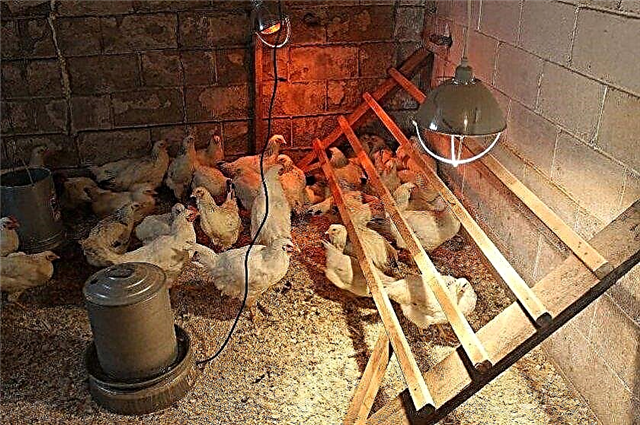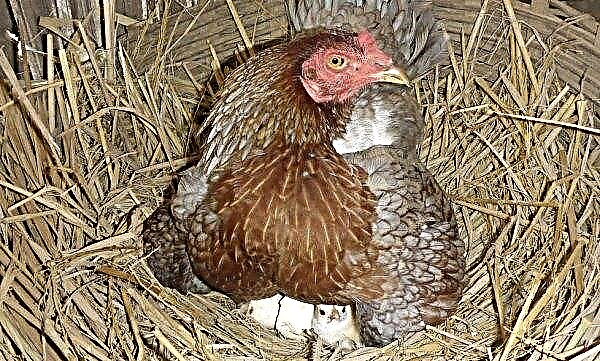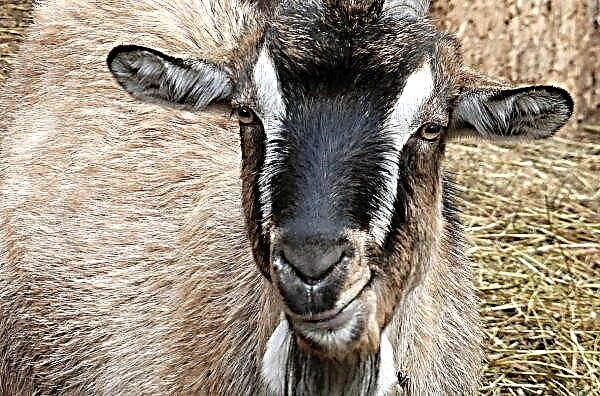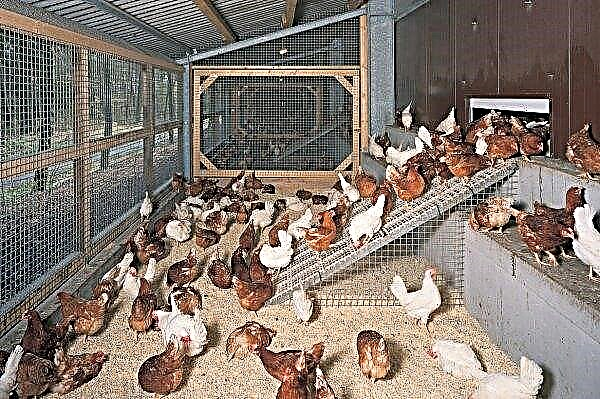The owners of the compound with poultry are trying to provide in their chicken coop the best conditions for life and the highest productivity of chickens. In the list of necessary equipment, lighting occupies a special place. Consider why you need to light the chicken coop, and what kind of lamps for this is best to choose, the optimal provision of room light for chickens.
Why do we need light in the chicken coop
Lighting the chicken coop is simply necessary in the winter, when the bird is kept in the chicken coop and is far from always walking, and the light from the window openings in the cold season is not always enough to just examine the food. Chickens have poor eyesight and practically do not see in the dark, so they just need lighting when eating food. This is especially true for young animals, which are fed several times a day, including night feeding.

In addition, the presence of light affects the following parameters:
- for the best egg laying of chickens, the daylight should be approximately 14-16 hours per day. In winter, this is possible only with the help of established lighting;
- promotes more intensive weight gain, because chickens can only feed in the light;
- increases survival of young animals;
- stimulates the development of poultry, including sexual. In a chicken coop illuminated for at least 10 hours, hens begin to rush earlier;
- helps to avoid injuries;
- egg fertility is increasing;
- lighting can be controlled and provoke annual molting.
When increasing egg production in winter with artificial lighting, one should not forget that in order to obtain high productivity at this time other conditions should also be provided (temperature conditions, dryness and balanced food with vitamin and mineral supplements).Important! Constant light in the hen house is hardly needed. In chickens, bones and the immune system form at night, and changes in calcium metabolism necessary for the bird occur. Already on the 3rd day of life, chickens begin to accustom to the dark.
Pros and cons of different types of lamps
Every zealous owner of the chicken house wants to save on energy consumption and, of course, it is most rational to use lamps that consume electricity economically. Optimally, if their brightness can be adjusted, since at different periods of life, birds need lighting of different intensities.
Video: Lighting in the chicken coop
Let's consider in the table the advantages and disadvantages of different lighting lamps.
| Title | Positive traits | Negative qualities |
| Incandescent lamp | Cheap, fast and easy to maintain, have a good light range. They optimally illuminate the room pointwise. | It is irrational to use for large rooms (in poultry farms). They consume a lot of electricity. |
| Fluorescent Lamp | Durable and easy to install and maintain. | They flicker somewhat, which irritates the bird, and have a not very good light range. Need disposal. |
| Energy saving lamp | Economical consume electricity. They have the ability to select the light range. | Dear ones, their brightness is not regulated. They do not always work out their full service life. It must be disposed of. |
| LED lamp | Hard-damaged, long-running and easy-to-maintain lamps with a good light spectrum. They have a small electricity consumption and the ability to adjust the light intensity. | High price. |
How to properly equip a lighting system in a chicken coop
When arranging a lighting system in a chicken coop, several factors must be taken into account: the required lamp power, color and flicker intensity, and on / off lighting fixtures. Consider the main points in providing lighting in the chicken room.
Did you know? Chickens do not perceive the violet part of the light spectrum, so the blue color for them is almost like darkness. Blue lamps are used in the house to capture and rearrange the herd.
How to calculate light brightness
The following recommended guidelines for chicken coop lighting are:
- for chickens that are born, a brightness of about 30–40 lux is needed;
- as it grows, brightness can be reduced and at the age of 14 days, 5–7 lx is enough for the chicks;
- for adults, a brightness of about 10 lux is enough, but if there is a rooster in the chicken coop, then it is better to increase the lighting to 15 lux.

In order to provide the chicken coop with good illumination, a simple calculation is used - for 6 square meters. m accounts for 60 watts. The required number of lamps depends on the total area. It is recommended to purchase fluorescent bulbs with a power of 40 watts. You can use fluorescent with flicker, but in order not to irritate the eyesight of birds, the flicker frequency should be 26 kHz. It is possible to opt for sodium light bulbs, which have a standard power of 50 watts. Such a lamp power is well suited for illumination in darker corners.
Did you know? If the birds begin to behave somewhat aggressively and pluck feathers from each other, then experts to solve this problem recommend lowering the brightness of the lighting.
Lamp color
What color of light can be better learned from the following information:
- blue color has a calming effect on birds, reduces aggressiveness;
- green color has a positive effect on the physical development of young animals;
- the red color is not entirely acceptable, since it can help to reduce the laying capacity of laying hens, but this color helps a lot in chickens;
- The orange color of the lamps improves egg production.

Where to place
When installing and placing a light supply system, it should be noted that the distance between the floor level and the light source should be about 2 meters. The gap between the lamps should be approximately the same, so that the illumination is uniform throughout the room.
The chicken room, as a rule, has high humidity, therefore it is recommended to equip all electrical wiring, sockets, electrical panels outside the house.
Important! To provide illumination of the house withThey advise taking thick shades and nets to protect the bulbs in order to protect the little hens from being injured by pieces of glass when breaking the lamp.
When to turn on
In the summer, birds also need natural light for growth and productivity, but in the fall, additional lighting should be taken into account.
Reducing sunlight in the winter leads to a slowdown in the metabolic processes in chickens and a decrease in productivity. Therefore, with the help of lighting, it is necessary to create a certain duration of daylight hours.
It is recommended to do it at least 10-14 hours a day. It is this duration that positively affects the puberty of the bird, that is, it accelerates it, and also helps to increase egg production by 20-30%.
Video: Coop lighting in winter
The following factors affect the duration of the selected daylight hours:
- feeding time;
- weight gain and height of broiler chickens;
- seasonal molt;
- cold or summer season;
- puberty and the ability to lay eggs.
The lighting for emerging chickens, young animals, broiler hens and laying hens is different. The first days of life, the chicks turn on the light for 23–24 hours, and then gradually reduce the duration to 8–9 hours over a period of 2–5 weeks and leave it that way for up to 18 weeks. Before the onset of egg production, daylight hours begin to lengthen, and at the peak of productivity, it is already 14-17 hours.Did you know? At the beginning of laying eggs, experts recommend using daylight hours of 7-10 hours. Gradually, every week it is increased by 15-30 minutes. This increases egg production by 17% compared with the content under constant 14-hour lighting;

The inclusion of additional lighting with the help of lamps usually begins in the second half of November, when the hens shedding time ends. To do this, at about 6 in the morning they turn on the light, and after sunrise they turn it off. After dark, the lamps are turned on again until 8-9 pm, and then turned off. In the morning the whole process is repeated anew.
In a small chicken coop, you can organize the light yourself. On large poultry farms it is convenient to install automatic lighting with a system that will allow you to turn on and off the light at a set time. Even in your house, you can connect the lamp to a timer purchased at the hardware store and save yourself the trouble of getting up early to turn on the light.
The gradual transition from light to dark and vice versa does not scare the little hens, but if the lights are turned off sharply, it can scare or cause a crush and riots. If you do not have lamps that have a smooth damping and switching on, then for a gradual transition from light to dark, several lights are used, which you can turn on not all at once.
Correctly adjusted lighting of the chicken coop will increase the productivity of poultry and extend it in the winter.













